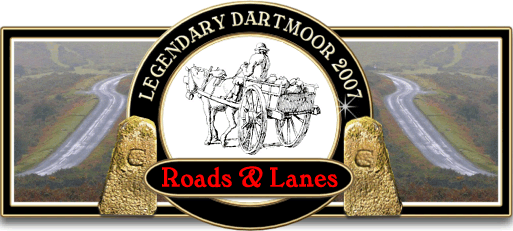
Dartmoor never has and never will be the easiest place to travel around especially in bad weather. Devonshire as a whole has the most mileage of roads of all the counties in Britain. It is literally criss-crossed with roads, lanes and tracks and it seems Dartmoor has its fair share of them. The sad thing is that in the main, the old roads of yesteryear are the modern roads of today and are expected to cope with the busy flow of traffic and the size of modern vehicles which becomes apparent in the busy months. The old bridges have been for many years trying to cope with cars, buses and lorries and the problem is shown below.
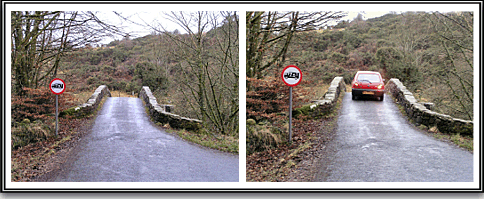
Originally the routes across Dartmoor consisted of tracks, there were monastic ways which linked the abbeys of Tavistock, Buckland, Plympton and Buckfast, such as the Abbott’s Way. Various trade routes were in existence such as the Jobber’s Path which carried goods across the moor. Numerous Church Paths were in use such as the Lych Way which conveyed people to and from church. In addition, many paths and tracks took folk to their place of work such as the mines, peat workings and quarries. Finally there were the various moorland routes which the farmers used for moving their livestock to and from the moor. All of these routes formed a network of paths which along with the lanes that linked the various towns, villages and hamlets for today’s modern roads and lanes. Below is a map which shows the early roads and track on Dartmoor up to around the late 1700’s. Also shown on the map are the many crosses or sites of crosses which marked many of the old tracks and give a good indication of trans-moor travel.
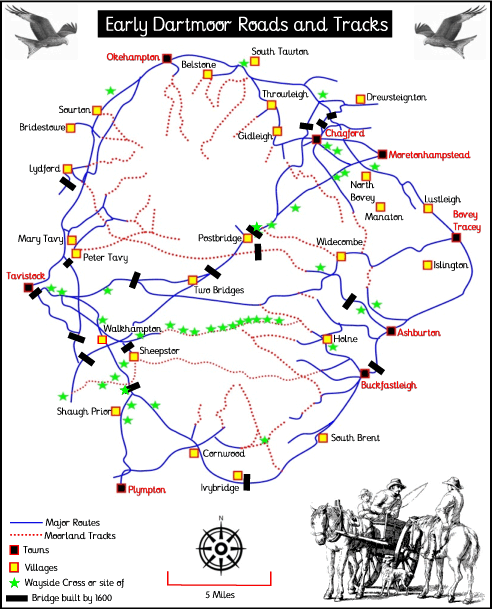
The introduction of the turnpike roads signalled the era of road building and improvement on the main moorland roads. There were two main reasons for the introduction of turnpikes, firstly by the 18th century the traffic on the roads had increased dramatically, and secondly, the old system whereby the roads were maintained by the various parishes became unworkable and many of the road conditions had become desperate. From the mid 1700’s landowners and business men saw the opportunity to make a good profit and so obtained Acts of Parliament which gave them permission to improve, maintain and in some cases build roads in return for charging tolls to travellers. The map below shows the main turnpike roads and toll gates on and around Dartmoor:
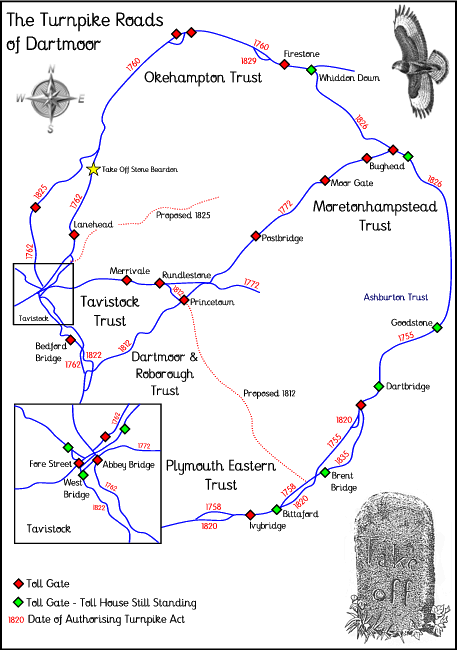
During the next 120 years there were 8 turnpike trusts who obtained around 50 Acts of Parliament to administer the roads of Dartmoor. The first roads to be ‘turnpiked’ were those which ran around the edges of the moor. The first trust to be established was that of Ashburton in 1755, quickly followed in 1758 by the Plymouth Eastern Trust, the Okehampton Trust in 1760, the Tavistock Trust in 1762 and the Moretonhampstead Trust in 1772. At first there was no dramatic change in the conditions of the roads but by slowly they were improved and in some cases new roads built which generally re-routed existing roads to bypass steep climbs such as the Moretonhampstead to Tavistock road and the new Lydford to Tavistock road.
One important remnant of the turnpike days is, or rather was, the ‘Take Off‘ stones. On the 20th of March 1800, the Government limited the number of horses that could be used with specified wheel widths on waggon and carriages on turnpike roads. For example a four-wheeled carriage with a wheel width of 9 inches was allowed no more than 8 horses to draw it, a two wheeled carried with a 9 inch wheel width was allowed up to 5 horses. This was all well and good until it came to a full load and a steep hill and in light of this there was an allowance for extra horses to be harnessed in order to climb the hill. This was where a gradient rose more than 4 inches in a yard or a 1 in 9 which in the old terms was not that steep. The point at where it was deemed possible to remove the extra pulling power was called the ‘Take Off Point’ and this was marked with a roadside stone called the ‘Take Off Stone’. Here all extra horses had to be un-harnessed thus reverting to the stipulated number.
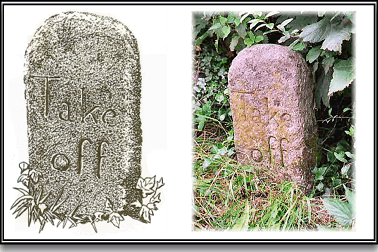
Even after the turnpikes travelling across Dartmoor still had its perils, the following reports are taken from early newspapers of the time:
January 1811.
“On the 26th as Mr Hutton, contractor for supplying Dartmoor prison with butcher’s meat was returning from Tavistock-market, in the evening, having dismounted to refresh his horse at a rivulet, it being dark, the animal escaped from him and endeavouring to recover it, Mr H. missed his way, and was precipitated into an old lead-shaft, upwards of 68 feet deep, but there being several feet of water in the bottom, his fall in some measure was broken. On rising to the surface, Mr H. laid hold of one of the cross-pieces, on which he supported himself; and he plainly heard the passengers conversing on the turnpike-road: but his efforts to make known his situation proving ineffectual, he endeavoured, by means of a pair of scissors, to dig holes in the side of the pit, to facilitate his ascension, and he got within a few feet of the surface, but the earth giving way, he was plunged into the dark abyss. He remained in this dreadful situation until the Friday following, when he was discovered by a labourer who was passing by; ropes were immediately procured, by which he was soon released from his perilous situation, and is now perfectly recovered.”
March 1829
“On Saturday last, as some persons were on the track of a fox on Dartmoor, near the Teign-head, a dog suddenly stood at bay, and it was found that the remains of the body of a man crossed their path. It had evidently lain in its then situation for some months: all traces of features had been destroyed by dogs or birds of prey, and so extensive had been the process of putrification, that, together with the rotten state of clothing, a separation of the limbs took place on the slightest touch. The hat was on the head, which was nearly separated from the body; but it was impossible to ascertain whether death had been occasioned by violence. From the remains of the clothing, as the body lay, it was imagined the deceased was a farmer’s servant; the jacket being short and of fustian, with a common blue waistcoat, corduroy breeches, blue stockings and a pair of shoes which had been mended. On Sunday an inquest was held on these remains before Joseph Gribble, Esq., one of the coroners for Devon, when nothing further could be elicited than from the evidence of a person who attended, and stated that, in November last, he met a person on the moor, who inquired the road across it to Okehampton, when he advised him, as being a stranger, to return and take the public road, and, from his recollection of the dress, he thought it highly probable these were the remains of that person. A common handkerchief and a halfpenny were all that were found on him. Under these circumstances, the jury found a verdict of “Found dead.” The inquest was held on the desolate spot on which the body was found, the snow lay thickly round, and so intense was the cold, that the coroner could merely record the verdict and procure the signatures of the jury, leaving an order that a shell be procured, and the body interred at Prince Town.”
July 1829.
“In the early part of July, when the weather was at its most inclement state, two boys, named Beer, the sons of a labouring man from South Zeal, one aged 13 the other only six, were sent with a donkey to part of Dartmoor to gather heath. After they executed the mission, one of those tempests which so frequently sweep over that desolate plain took place, and no doubt hastened their return. It seems that the elder lad sent his brother to fetch a bundle of heath which had been bound up for the purpose a short distance from them; he continued his way slowly home, accounting for his brothers’ not overtaking him by the supposition that he had passed him unobserved, and had reached home before him. When, however, he got to his father’s cottage, he found that nothing had been seen of him, and it was evident that the poor little boy had lost himself upon the plains. Upwards of 100 persons immediately started to search, but no trace of him was discovered, although the search was continued for nearly three months. About three weeks since, when it was generally believed that the little fellow had been washed away by the flood, a shepherd passing across the moor, not more than a quarter of a mile from the spot where the child was first missed, discovered a leather cap, and, upon searching further, the girth that had been used to tie the heath, and the thigh bone apparently of a child about six weeks of age. There were no other remains; but the wetness of the season, and the immense number of foxes and birds of prey abounding on these desolate and almost interminable moors, render it too certain that the child had been torn piecemeal by them, and that his clothes, which must have become rotten, were dragged away with the human flesh attached to them. It is the opinion of those who went in search of him, that neither the poor child nor any human being lost upon Dartmoor, and scantily clothed as he was, could have lived through a night so tempestuous.”
August 1837
“On the 5th of August, John Dawe, a superintendent of a quarry was ” returning home on horseback about 10 o’clock at night. When he arrived near a plantation about a mile and a half from Okehampton, two men seized his horse, while two others seized him and dragged him from his horse. Dawe called out “Murder,” upon which one of the men said if he made any alarm they would murder him at once, and he was then struck violently on the head until he sank down perfectly insensible. On his coming to his senses he found his pockets had been rifled, and a £5 note, several sovereigns, and a quantity of silver, had been taken. Information was sent to Okehampton. About 12 o’clock that night the prisoners called on a lodging-house-keeper, and in tendering some money in payment the prisoner, Murphy took from his pocket a large quantity of money. There was a spot of blood on the trousers of Murphy. The prisoners left shortly afterwards. On the following day Murphy and Dean were apprehended at Winckley (Winkleigh) and Lewis and Andrews were taken into custody at Southampton… The jury found the prisoners guilty, and judgement of death was recorded against them.”
July 1847.
“After a lapse of nearly a century, the Quicksilver mail, in the course of a few days will leave the road, driven off by that mighty monster steam, who brings revolution and change wherever he goes. Half a century since, in the recollection of many an old personage now living in town (Ashburton), once a day passed the Diligence coach, with its huge basket fastened behind for passengers who could not afford to pay the top fare… That well-known whip of olden days, Crack, always stopping with his coach at the Anchor Inn, South Brent, to amuse his passengers with a few games at cards, in which he was noted for dexterity &c. After stopping one hour, “regular time allowed,” off again over the celebrated Dean Clapper-hill, on to Ashburton. Not making much delay here, he would proceed to the celebrated New Inn, five miles from Ashburton. Here, to the amusement of some passengers, and the annoyance of others, old Crack would dine, and enjoy a battle of gamecocks, which were always procured ready for the fight.
A great improvement now took place, and the old Regulator, Subscription, Defiance, and a host of other coaches, have passed away, the distance between Exeter and Plymouth having been reduced from 12 hours to five. On Monday last the celebrated coach Tantivy, with its guard John Goodwin, bade adieu to this line of road. His bugle will be heard no more by us from the roof of the Tantivy. The dear old spinsters, who used to warm up into life at the sound of his horn, are thrown into irreparable loss.“
January 1866.
“The danger of crossing Dartmoor by bypaths in order to effect a saving of distance has been enforced by another death, which it may be hoped will deter others from repeating this practice. Mr H. A. Vallack, county coroner, has held an inquest at the London Inn, Princetown, on the body of Richard Allen of Sourton, who left his home to go to Sticklepath, and attempted to cross a portion of Dartmoor, in order to save three miles. On the following afternoon, Mr. John Guard of Youlditch, guided by the instinct of a sheepdog, found Allen in a sitting posture, and with an umbrella under his feet, under the rock near the place called the Island of Rock, on the west of Okement river, whither the unfortunate man had probably gone to shelter himself during the boisterous night, and where he probably died from exposure and fatigue. Police constable Madden found in the deceased’s pocket £2. 12s. 6d. Deceased was 50 years of age.”
September 1868.
“Miss Hammond, a young lady visiting at Chagford Rectory, Devon was stopped near Rushford Bridge, near Chagford, about 6 o’clock on Friday evening, by three men, who, after threatening her with personal violence demanded her watch and money. She with great coolness refused to comply with the demand; at this time, very fortunately, approaching footsteps were heard and the men disappeared.”
May 1908.
“… in the West country, more conspicuously than anywhere else, miles upon miles of road practically ruined not by motor-cars but by traction engines. Between Exeter and Okehampton especially, and in the neighbourhood of Bovey Tracey, the surface had been broken all to pieces by these engines…“
Below is a good example of one of the many small lanes which run on the edges of Dartmoor. Today, this is classified as a Green Lane as clearly traffic no longer uses it. Its age becomes apparent when the leaf canopy is taken into account, insomuch as the way both hedges meet over the lane and also the coppicing of the trees that make up the hedge. The banks on which the hedge stand are also typical of a Dartmoor/Devonshire lane. But if one was to imagine a laden packhorse train coming down Mucksey’s Lane, it is apparent how nothing coming up would be able to pass. For this very reason many of the packhorses would have bells on their harnesses to warn other travellers of their approach. There can be no question that the Dartmoor road builders displayed an unrivalled skill in view of the topography in which they worked. There is a story concerning a stretch of road somewhere near Hurston where a gang of road wardens were repairing it. A passer-by noticed that the stone that the wardens were using was being brought from a stream which was a fair distance away. In an early time and motion study the stranger pointed out that to save time and effort it would be easier to blast the rock from nearby granite sources. The wardens heeded the advice, blasted out the granite, repaired the road which was then laid with tarmac. Within the year this stretch of the road had completely disappeared. Why, because under the road was a peat bog and the sharp granite chips had cut through the peat thus allowing the road to sink. Whereas the earlier stretch which had be repaired with the stones from the stream stood firm because the stones were smooth and round and lay on the peat in a stable layer and did not cut through the peat.
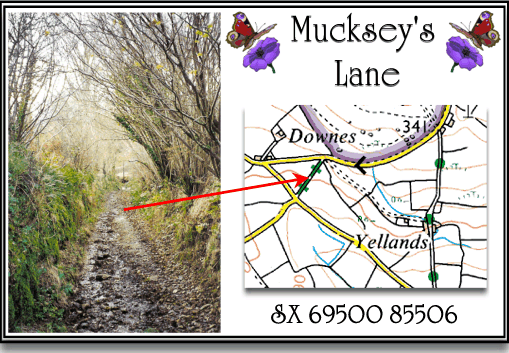
A good example of the early state of the roads is the following poem, if a man of the cloth can liken marriage to a Devonshire lane then it surely must indicate a degree of hardship?
Marriage is Like a Devonshire Lane.
Rev. John Marriott.
In a Devonshire lane. as I trotted along
T’ other day, much in want of a subject for song,
Thinks I to myself, I have hit on a starin;
Sure, marriage is much like a Devonshire lane.
In the first place, ’tis long, and when you are in it,
It holds you as fast as a cage does a linnet;
For howe’er rough and dirty the road may be found,
Drive forward you must, there’s no turning round!
But though ’tis so long, its not very wide;
For two are the most that together can ride;
And e’en then ’tis a chance but they get in a pother,
And jostle and cross, and run foul of each other.
Oft poverty greets them with mendicant looks,
And care pushes by them, o’erladen with crooks
And strife’s grazing wheels try between them to pass,
And stubbornness blocks up the way on an ass.
Then the banks are so high, to the left and the right,
That they shut up the beauties around them from sight!
And hence, you’ll allow, ’tis inference plain,
That marriage is just like a Devonshire lane.
But, thinks I too, these banks, within which we are pent,
With bud, blossom, and berry are richly besprent;
And the conjugal fence, which forbids us to roam,
Looks lovely when decked with the comforts of home.
In the rock’s gloomy crevice the bright holly grows,
The ivy waves fresh o’er the withering rose;
And the evergreen love of a virtuous wife
Soothes the roughness of care, cheers the winter of life.
Then long be the journey, and narrow the way,
I’ll rejoice that I’ve seldom turnpike to pay;
And, whate’er others say, be the last to complain,
Though marriage is just like a Devonshire lane.
 Legendary Dartmoor The many aspects past and present of Dartmoor
Legendary Dartmoor The many aspects past and present of Dartmoor
